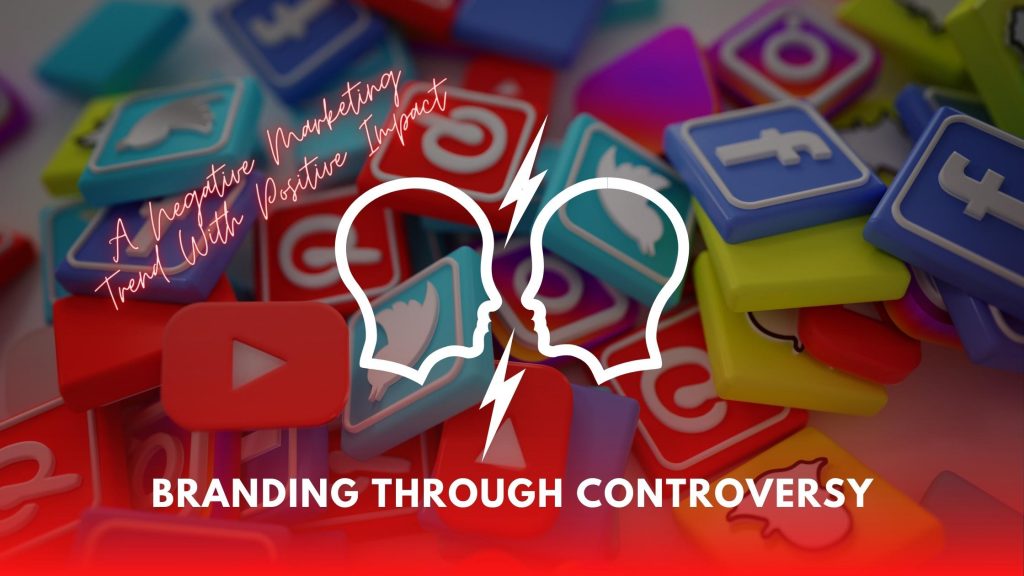Branding often comes up with new strategies to meet ongoing trends. That’s where the concept of controversial marketing comes from. It is also referred to as negative marketing, shockvertising, or shock advertising. Simply, the idea is to give a shock and create a buzz in the market, often preferably among netizens. The trend has become one of the most effective marketing strategies today.
Branding through controversy is controversial. This is the reason marketers are reluctant to pursue it. The core idea of controversial management survives and thrives on the provocative, disturbing, offensive, diverse moral, racial, political, and religious value proposition. Anything that will hit the market like a storm and create an argument about their brand name or product is marked as controversial marketing.
How Does Negative Marketing Work?
The concept of controversy or negative marketing has always been a critical discussion among strategy makers. But the question is why? Because it is the image uplift a brand or the product line needs. It leaves an imprint on the customer’s mind, the brand name, and the product, which leads them to search for it. You can anticipate that the Controversy marketing works somehow dramatically. But the truth is it uses simple facts of biology and socio-psychology.
The amygdala and prefrontal cortex of the brain are the only parts of the human body that regulate how we feel and pay attention. Then there is the socio-psychological impact that makes the trending news floating in the marketplace take over these parts of the brain. It attracts them more and more towards the controversy, aka the brand. It is purely logical.
Is Negative Marketing Hit Or Miss?
Yet, the question remains, is it a hit or miss? Spreading a controversy is straight free publicity. It helps gain time in the spotlight, which is the primary goal of any brand. Sales do rise quickly while the buzz is still going on. Many would contend that the negative reputation it fosters is detrimental to a long-term company goal. However, that would not change the fact that shock advertising works.
Negative Marketing done right: Real Life Implications.
Every year hundreds and thousands of local, national, and international brands/products benefit from negative or diverse marketing strategies. Some mentionable would be the AIRBNB – #WEBELONG campaign. They raised their voice against American politics insinuating immigrants and people of colored skin are less acceptable. It built its image and increased yearly grossing by pointing out the political norm, and that is all.
Then there is Nestle Yorkie’s “not for girls” tagline, it had projected as sexist in the market, and they had to change the tagline soon afterward. But was it sexist really? Because the Yorkie bar sold out as soon as it was out. It was One of their most sensational product lines back in 2002.
And the NIVEA “white is purity” has made more noise than any product ever. The commercial had struck every mind by directly pinning it to the racist practices that are overt and white supremacist. Respect gain and brand extension were the results of it. So, Controversy marketing is one of the best strategies there is.
When It Went Wrong?
There are some downsides to the strategy. More than 60% of shock advertising is subject to failure. That is only because the strategies get banned by the motion of other competitors and critics in the market. You can not know it is forbidden unless you have tried it first, right? Like the Caribu Bitter— the “Canari” commercial of 2009 was marked as promoting violence by children.
Then there was the Droit des Non-Fumeurs— “Smoking is being a slave to tobacco” commercial was marked as sexually provocative. Even the slightest change in the tone of a commercial makes it a subject of overview and legal evaluation. So, that is why most shock-advertising tactics are considered false attempts. But the fun part is that even though the strategies are banned, they still create a buzz and keep the brand in the news, making them more exposed than ever. So it is a win-and-win situation.
Feasibility Evaluation of Negative Marketing.
Let’s talk about its feasibility in the long run. Until now, we know it works, it is a short-term strategy, and its effect lures for a short period. And there is just one way to make it work in the long run: continuously dropping jaw-dropping controversies in the market. Creating a timeline where controversial marketing is dated at a safe distance with regular strategies will always keep giving the brand name the uplift it needs.
So keeping it borderline legal and blowing some minds off with a bold move is the only way to keep a controversy alive and trending. Now, there is a reason why we still encourage shock commercials, given that their upfront failure rate is high, they have a short lifespan, and they generate contradicting publicity. That is because Shock advertising energizes the market and draws further attention to the brand, and in the digital era, nothing ever goes away. Additionally, one person’s news is always another person’s controversy.
Conclusion
The marketing teams of every brand find the discussion of shock advertising to be significantly interesting. Since it regularly produces results, despite the fact it may have scared some individuals away. Here, the goal is to intentionally propagate a rumor or dispute to attract the interest of the entire market. Alienating the target audience or publishing scathing comments about the brand, the merchandise, or the service are examples. Shockvertising refers to something that can catch the public’s attention and lure them into focusing on just that one brand.



